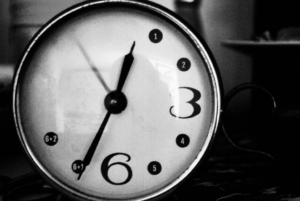The Circle of Drumming Mastery
Using the clockface to define what you hear: From messy to mastery!

Keeping time might have a new meaning!
The Circle of Drumming
-
At 12:00, we begin: someone who has never touched a drumstick. No experience, no technique, just curiosity.
-
As they move clockwise to around 1:00, they start playing, but it’s still chaotic. Maybe they’ve picked up a pair of sticks and are just hitting things. It sounds random, because it is. There’s no control or context, just exploration.
-
As they progress downward, through 2:00 to 3:00, something happens: structure forms. They learn rudiments, timing, and groove.
-
At about 6:00, they’ve arrived at what most people would call a “good drummer,” or a “very good drummer” even! They can hold down a solid pocket, improvise tastefully, and maybe even adapt across a few different genres. Drummers and non-drummers alike recognize their skill.
From Mastery to Artistry
Back at the Top: Noise or Nirvana?
Why This Matters
Hour, Minute, and Second Hands
Putting it All Together
As you can see, the top half of the clock on either side is abstract, while the bottom half is more concrete. The lower hours are where drummers communicate clear, tangible skills: technique, rhythm, timing, coordination. You can see the brushstrokes here. It’s like watching a realist painter, every detail has a purpose, and every element is easy to identify.
The top half of the clockface, drummers are communicating emotion, texture, even ambiguity (whether on purpose or not; depending on the side of the clock). Think of someone that is just starting drums, the way they hit the drum is pure emotion, with no purpose other than to communicate expressively. On the other side, we see the same thing, but this time it’s intentional. And just like in visual art, what may look (or sound) simple to a casual observer is often hiding years of mastery underneath.
So let’s break it down even further. Here’s how the clockface of drumming parallels the evolution of artistic expression, and why mastering the top of the circle might just be the hardest part.
12:00 — Naïve Art / Childlike Expression
-
The Blank Canvas
-
Art Style: Naïve Art, Cave Paintings, Children’s Drawings
-
Drumming Parallel: Random hits, pure curiosity, no awareness of form.
-
Mindset: “What happens if I hit this?”
-
Intent: None yet—it’s about discovery.
1:00–2:00 — Folk Art / Outsider Art
-
The Dabbler
-
Art Style: Folk Art, Art Brut (Raw Art)
-
Drumming Parallel: Untrained but expressive. Instinctual grooves, maybe out-of-time, but emotionally honest.
-
Intent: Emerging, but technique hasn’t caught up.
3:00–5:00 — Realism / Academic Art
-
The Sketcher / Builder
-
Art Style: Academic Realism, Classical Painting
-
Drumming Parallel: Rudiments, metronome work, clean execution. Mastering tools.
-
Mindset: “How do I do this right?”
-
Intent: Technical correctness, structure, clarity.
6:00 — Renaissance / Golden Age
-
The Composer / Architect
-
Art Style: Renaissance, Baroque, Neoclassicism
-
Drumming Parallel: Mastery. Groove, touch, musicality. You know when not to play.
-
Mindset: “Serve the art. Make it timeless.”
-
Intent: Music before ego. Craft with clarity, expression, and taste.
-
Examples: Leonardo, Caravaggio, Velázquez → Steve Gadd, Nate Smith, Carter McLean
7:00–8:00 — Impressionism / Cubism / Modernism
-
The Innovator / Re-imaginer
-
Art Style: Impressionism, Cubism, Modernist Abstraction
-
Drumming Parallel: Playing with over-the-barline subdivisions, metric modulation, implied time, displacements. Still rooted, but pushing form.
-
Mindset: “What if we see time differently?”
-
Intent: Stretching the medium. Deep control, fresh interpretation.
-
Painters: Picasso, Monet, Cézanne → drummers like Mark Guiliana, Brian Blade, Eric Harland
9:00 — Abstract Expressionism / Dada
-
The Edgewalker
-
Art Style: Pollock, de Kooning, Dada, Surrealism
-
Drumming Parallel: Controlled chaos. Intentional randomness. Asymmetrical phrasing. Might abandon pulse entirely.
-
Mindset: “The form is the message.”
-
Intent: Deep experimentation. Borderline alienating or electrifying.
10:00–11:00 — Conceptual Art / Minimalism / Fluxus
-
The Disruptor
-
Art Style: Wassily Kandinsky, Duchamp, Fluxus, John Cage, Mark Rothko, Cy Twombly, Agnes Martin
-
Drumming Parallel: Performances that deconstruct what drumming even is. Silence, found sounds, theater. Rhythmic philosophy.
-
Mindset: “Why is this a drum solo?”
-
Intent: Challenge the idea of music itself.
12:00 (again) — Zen Calligraphy / Art as Being
-
The Mirror
-
Art Style: Zen Ink Painting, Performance Art, Mysticism
-
Drumming Parallel: Drumming as presence. Every hit is meditation. Could be noise or nothing. It’s the awareness that matters.
-
Mindset: “I am the drum.”
-
Intent: You’ve let go. You’re not trying to be good, you just exist as the sound of a drum.
Where you are on the clock doesn’t matter as much as the fact that you’re moving. The circle isn’t just about skill, it’s about awareness. Simple might be hard. Wild might be wise. Keep listening, keep growing, and use the clock as a reference along the way.
This article goes hand-in-hand with the article of Drumming Levels Explained: The Standard 6 You Know, and Now More Beyond. Read that here!



